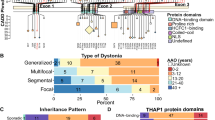Abstract
Primary torsion dystonia is a clinically and genetically heterogeneous group of movement disorders. Fifteen different types of dystonia have been described to date, of whom 14 loci have been mapped, but only seven genes identified. Several different modes of inheritance have been described, including autosomal dominant transmission with reduced penetrance (12 loci), recessive X-linked (one locus), and autosomal recessive transmission (three loci). In this study, we describe the localization of a novel form of autosomal recessive, primary focal torsion dystonia using a genomewide search in a large consanguineous Lebanese family with three affected individuals. Homozygosity mapping with 382 microsatellite markers was conducted. Linkage analysis and haplotype construction allowed us to identify a novel locus designated as DYT17, within a 20.5-Mb interval on chromosome 20. Of the 270 known genes spread on this interval, 27 candidate genes were tested and excluded as responsible for the disease. Fine mapping by identification of other dystonia families linked to chromosome 20 and sequencing of candidate genes in the refined interval is required in order to identify the causative gene in DYT17.



Similar content being viewed by others
References
Brin MF, Fahn S, Moskowitz C et al (1987) Localized injections of botulinum toxin for the treatment of focal dystonia and hemifacial spasm. Mov Disord 2(4):237–254 doi:10.1002/mds.870020402
Tarsy D, Simon DK (2006) Dystonia. N Engl J Med 355(8):818–829 doi:10.1056/NEJMra055549
Fahn S, Bressman SB, Marsden CD (1998) Classification of dystonia. Adv Neurol 78:1–10
Bressman SB (2004) Dystonia genotypes, phenotypes, and classification. Adv Neurol 94:101–107
Geyer HL, Bressman SB (2006) The diagnosis of dystonia. Lancet Neurol 5(9):780–790 doi:10.1016/S1474-4422(06)70547-6
Camargos S, Scholz S, Simón-Sánchez J et al (2008) DYT16, a novel young-onset dystonia-parkinsonism disorder: identification of a segregating mutation in the stress-response protein PRKRA. Lancet Neurol 7(3):207–215 doi:10.1016/S1474-4422(08)70022-X
Breakefield XO, Blood AJ, Li Y et al (2008) The pathophysiological basis of dystonias. Nat Rev Neurosci 9(3):222–234 doi:10.1038/nrn2337
Bressman SB, de Leon D, Brin MF et al (1989) Idiopathic dystonia among Ashkenazi Jews: evidence for autosomal dominant inheritance. Ann Neurol 26(5):612–620 doi:10.1002/ana.410260505
Grimberg J, Nawoschik S, Belluscio L et al (1989) A simple and efficient non-organic procedure for the isolation of genomic DNA from blood. Nucleic Acids Res 17:8390 doi:10.1093/nar/17.20.8390
Delague V, Bareil C, Tuffery S et al (2000) Mapping of a new locus for autosomal recessive demyelinating Charcot-Marie-Tooth disease to 19q13.1–13.3 in a large consanguineous Lebanese family: exclusion of MAG as a candidate gene. Am J Hum Genet 67:236–243 doi:10.1086/302980
Lindner TH, Hoffmann K (2005) easyLINKAGE: a PERL script for easy and automated two-/multi-point linkage analyses. Bioinformatics 21(3):405–407 doi:10.1093/bioinformatics/bti009
Rozen S, Skaletsky H (2000) Primer3 on the WWW for general users and for biologist programmers. Methods Mol Biol 132:365–386
Giménez-Roldán S, Delgado G, Marín M et al (1988) Hereditary torsion dystonia in gypsies. Adv Neurol 50:73–81
Kong X, Murphy K, Raj T et al (2004) A combined linkage-physical map of the human genome. Am J Hum Genet 75:1143–1148 doi:10.1086/426405
Pisani A, Bernardi G, Ding J et al (2007) Re-emergence of striatal cholinergic interneurons in movement disorders. Trends Neurosci 30(10):545–553 doi:10.1016/j.tins.2007.07.008
Hamann M, Richter F, Richter A (2007) Acute effects of neurosteroids in a rodent model of primary paroxysmal dystonia. Horm Behav 52(2):220–227 doi:10.1016/j.yhbeh.2007.04.006
Burgunder J, Richter A, Löscher W (1999) Expression of cholecystokinin, somatostatin, thyrotropin-releasing hormone, glutamic acid decarboxylase and tyrosine hydroxylase genes in the central nervous motor systems of the genetically dystonic hamster. Exp Brain Res 129(1):114–120 doi:10.1007/s002210050941
Binda AV, Kabbani N, Lin R et al (2002) D2 and D3 dopamine receptor cell surface localization mediated by interaction with protein 4.1N. Mol Pharmacol 62(3):507–513 doi:10.1124/mol.62.3.507
Parra M, Gee S, Chan N et al (2004) Differential domain evolution and complex RNA processing in a family of paralogous EPB41 (protein 4.1) genes facilitate expression of diverse tissue-specific isoforms. Genomics 84(4):637–646 doi:10.1016/j.ygeno.2004.06.004
Gasnier B (2004) The SLC32 transporter, a key protein for the synaptic release of inhibitory amino acids. Pflugers Arch 447(5):756–759 doi:10.1007/s00424-003-1091-2
Rohrer L, Raulf F, Bruns C et al (1993) Cloning and characterization of a fourth human somatostatin receptor. Proc Natl Acad Sci USA 90(9):4196–4200 doi:10.1073/pnas.90.9.4196
Gerhard DS, Wagner L, Feingold EA et al (2004) The status, quality, and expansion of the NIH full-length cDNA project: the Mammalian Gene Collection (MGC). Genome Res 14(10B):2121–2127 doi:10.1101/gr.2596504
Nagase T, Ishikawa K, Suyama M et al (1999) Prediction of the coding sequences of unidentified human genes. XIII. The complete sequences of 100 new cDNA clones from brain which code for large proteins in vitro. DNA Res 6(1):63–70 doi:10.1093/dnares/6.1.63
Ota T, Suzuki Y, Nishikawa T et al (2004) Complete sequencing and characterization of 21,243 full-length human cDNAs. Nat Genet 36(1):40–45 doi:10.1038/ng1285
Acknowledgements
We are grateful to the family for making this research possible. This work was supported by grants from the Saint Joseph University and the Agence Universitaire de la Francophonie.
Author information
Authors and Affiliations
Corresponding author
Rights and permissions
About this article
Cite this article
Chouery, E., Kfoury, J., Delague, V. et al. A novel locus for autosomal recessive primary torsion dystonia (DYT17) maps to 20p11.22–q13.12. Neurogenetics 9, 287–293 (2008). https://doi.org/10.1007/s10048-008-0142-4
Received:
Accepted:
Published:
Issue Date:
DOI: https://doi.org/10.1007/s10048-008-0142-4




